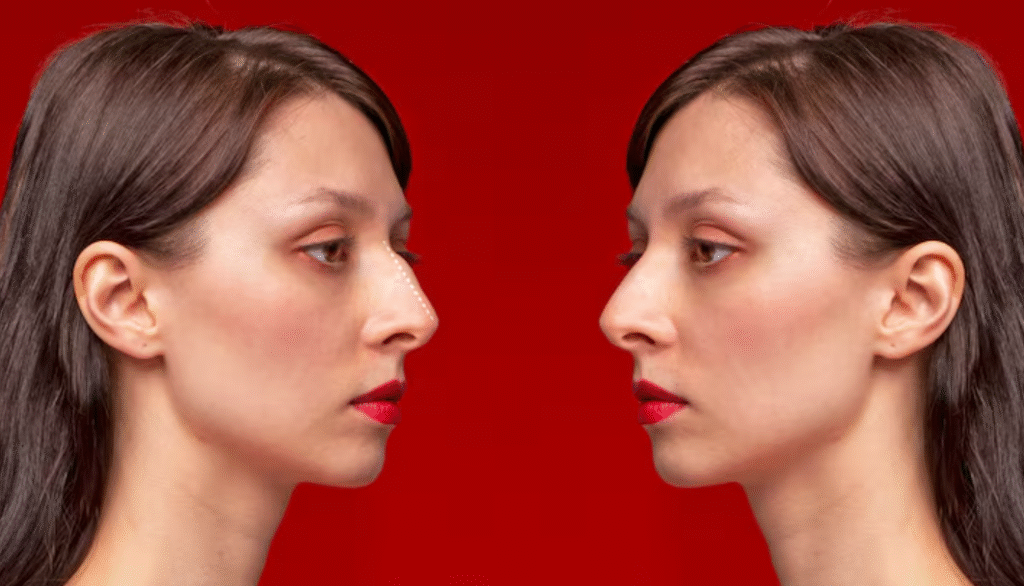Treatment Overview
Tip refinement ethnic rhinoplasty focuses specifically on reshaping and refining the nasal tip, which is often a key aesthetic concern among patients of various ethnic backgrounds. Many individuals from Asian, African, Hispanic, Middle Eastern, or Native American heritage may have a bulbous, wide, drooping, or poorly defined nasal tip due to thicker skin, weaker cartilage, or genetic factors.
In Korea, surgeons specialize in advanced rhinoplasty techniques that allow for precise tip refinement while preserving ethnic identity. Using cartilage grafting, suture techniques, and state-of-the-art approaches, they create a natural, elegant nasal tip that balances with the patient’s facial proportions.
Purpose & Benefits
Tip refinement ethnic rhinoplasty aims to enhance tip definition without erasing cultural identity. Benefits include:
- Narrowing and reshaping a bulbous or wide tip.
- Enhancing nasal tip projection for a more balanced profile.
- Correcting droopy or downward-pointing tips.
- Achieving a more elegant, natural nasal contour.
- Preserving unique ethnic features while refining overall appearance.
- Improving nasal symmetry and proportionality.
Ideal Candidates
This procedure is ideal for patients who:
- Have a bulbous, wide, drooping, or undefined nasal tip.
- Desire improved definition while maintaining their ethnic identity.
- Seek subtle yet noticeable refinement of nasal aesthetics.
- Have realistic expectations and are in good overall health.
- Want surgery performed by specialists experienced in ethnic rhinoplasty.
Possible Risks & Complications
While generally safe in the hands of experienced Korean surgeons, risks may include:
- Swelling and bruising around the nasal tip.
- Over- or under-correction of the tip shape.
- Scar tissue formation in thicker-skinned patients.
- Cartilage graft absorption or irregularity (rare).
- Temporary numbness in the tip.
- Very rare need for revision surgery.
Surgical Techniques Used
Tip refinement rhinoplasty in Korea may involve a combination of techniques, such as:
- Cartilage Suturing Techniques: Including dome-binding, interdomal, and transdomal sutures to create definition.
- Cartilage Grafting: Using septal, ear, or rib cartilage for projection and structural support.
- Alar Base Reduction (if needed): To narrow flared nostrils.
- Tip Defatting: Removing excess soft tissue in thick-skinned patients for sharper definition.
- Shield Graft or Cap Graft: To enhance tip shape and projection.
- Open or Closed Approach: Depending on complexity and patient anatomy.
Recovery & Aftercare
- Swelling & Bruising: Tip swelling may take longer to subside, usually 2–3 weeks for noticeable improvement, with full refinement up to 12 months.
- Downtime: Most patients return to normal activities within 10–14 days.
- Splints & Dressings: External splints may be required for a week; sutures are removed after 5–7 days.
- Aftercare in Korea: Includes swelling management therapies (LED light, anti-swelling injections, scar prevention care).
Results & Longevity
Tip refinement rhinoplasty results are long-lasting, as cartilage reshaping and grafting provide durable structural support. Patients can expect a more defined, balanced, and harmonious nasal tip that enhances overall facial aesthetics while respecting ethnic identity.
Treatment Process in Korea
1. Consultation
- 3D simulation and nasal analysis to preview results.
- Discussion of cultural identity and individual preferences.
2. Pre-Surgery Preparation
- Medical evaluation, blood tests, and nasal examination.
- Personalized surgical plan created for balanced refinement.
3. Surgery
- Performed under general or twilight anesthesia.
- Duration: 2–3 hours, depending on complexity.
- Cartilage reshaping, grafting, and suturing techniques applied.
4. Immediate Recovery
- Splints placed for stabilization.
- Monitored for a few hours post-surgery before discharge.
5. Follow-Up Care
- Stitches removed in 5–7 days.
- Regular follow-up visits with swelling control treatments.
- Aftercare programs tailored for international patients.
Why Korea?
- Ethnic Expertise: Korean surgeons excel in ethnic rhinoplasty, understanding variations in nasal anatomy.
- Advanced Techniques: Use of cartilage grafting and precise sutures ensures refined yet natural results.
- Medical Tourism Support: Clinics provide translation, recovery care, and international patient services.
- Balanced Outcomes: Emphasis on preserving ethnic identity while achieving aesthetic improvement.
Cost Range
The cost of tip refinement ethnic rhinoplasty in Korea varies with complexity and surgical methods used.
- General Price Range: ₩6,000,000 – ₩12,000,000 KRW (approx. $4,800 – $9,600 USD).
- Basic Packages Include: Surgeon’s fee, anesthesia, surgery, and post-op care.
- Premium Packages May Include:
- Rib cartilage grafting (if needed)
- Advanced imaging simulations
- Post-op scar management and swelling therapy
- VIP patient care with interpreters and transport
Popular Clinics
- ID Hospital (Seoul): Leading center for ethnic and tip refinement rhinoplasty.
- Banobagi Plastic Surgery: Known for creating natural tip definition with advanced techniques.
- JW Plastic Surgery: Specializes in cartilage grafting and tip reconstruction.
- View Plastic Surgery Clinic: Offers extensive aftercare for international patients.
- MINE Plastic Surgery Clinic: Focuses on minimally invasive, natural-looking refinements.




